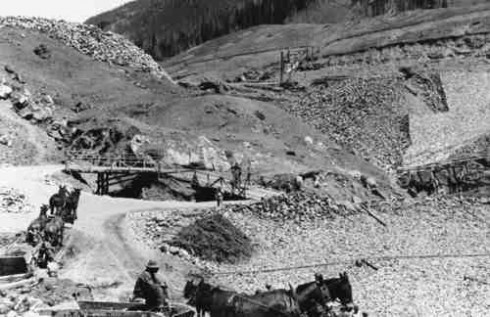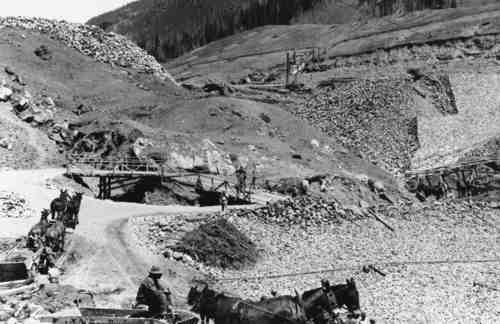Article by Melvin and Camille Getz
Water – July 2007 – Colorado Central Magazine
WAY BACK IN 1952, the San Luis Valley celebrated a major water-related centennial. That event recognized the 1852 People’s Ditch of San Luis as the very first irrigation right granted in Colorado and noted the great accomplishments and challenges of one hundred years of irrigation. Governor Dan Thornton delivered the keynote address, and almost every notable water authority in the state took part in one way or another — speaking, listening, eating, and even marching in a parade through the streets of San Luis. The 1952 celebration is documented in a publication put out by the Colorado Water Conservation Board and Colorado Agricultural and Mechanical College (now CSU) entitled A Hundred Years of Irrigation in Colorado; 100 Years of Organized and Continuous Irrigation; 1852-1952.
So what was the second biggest occasion in San Luis Valley water history? And is it reason enough for a similar celebration?
We think it is and so do a lot of other folks. We haven’t gotten a response to our invitation from the Governor yet, but the list of committed participants to “100 Years of San Luis Valley Reservoirs” reads like a “Who’s Who” of Colorado and Rio Grande Basin water people.
Locals and visitors alike will gather July 23 – 25 to learn from these experts about the past, present, and future of water storage in the Rio Grande Basin — and we also expect to have fun! There are activities geared for serious water scholars, for kids, and everyone in between.
Questions to be discussed include: Why store water? Why was 1907 the pivotal year for water storage in the San Luis Valley? What is the present situation of valley dams and reservoirs? How can San Luis Valley reservoirs be better used? What is the future of water storage in the entire Rio Grande Basin? Is it possible to work together within the valley and within the basin to care for this most precious resource? Do we have to wait another 50 or more years to throw a valley-wide party?
A Little History
The San Luis Valley in southern Colorado derives its shape, and its sustenance from the San Juan and Sangre de Cristo mountains that form its west, north, and eastern boundaries. When the snow that falls along high peaks and deep mountain valleys melts, it flows down creeks and rivers that feed a huge irrigation canal system and underground aquifers. It is that water that makes life possible in this high desert valley. And it is the management of that water that has made a way of life — agriculture — sustainable. The San Luis Valley is among the most intensely irrigated areas in the country.
People have been drawn here for fertile land and ample water since the mid-1800s. A little later, land promoters and railroad barons developed farms across the valley, promising that plenty of water would be diverted from the rivers and delivered through newly built canals and ditches. But when the drought of the 1890s came, high expectations withered like the crops. There was not enough water, and what did make it into the valley came at the wrong time for farmers.
Valley residents realized they needed to control the runoff by building dams.
And then in 1896, the federal government “reared its ugly head” and imposed an embargo on building reservoirs because drought had caused hardship all along the Rio Grande. Mexico threatened to sue for its share of the river. To avoid an international crisis, the government refused permission to impound water over public land — a simple way to restrict development and upstream water usage.
It was a devastating ruling for the independent-minded (or some might say stubborn, anti-government radical) residents of the San Luis Valley. Mass meetings were attended by desperate, frustrated farmers who sent representatives of the valley again and again to Washington, D.C., pleading for authorization to build reservoirs.

During this time the Reclamation Service (name since changed to the Bureaur of Reclamation) was established and that further eroded trust between the San Luis Valley and the government, with good reason as subsequent actions were to prove. Animosity and suspicion amongst people of Colorado, New Mexico, and Texas accelerated and in some ways has continued to this day.
Finally in 1907, with a partial lifting of the embargo, which was eventually deemed illegal, an amazing number of projects on the Upper Rio Grande and its tributaries were set in motion. The pent-up energies of a repressed population led to a wild frenzy of activity at potential reservoir sites.
These tremendous efforts required harsh work in primitive conditions using tools and machinery dwarfed in scale by the magnitude of the projects. Construction was constantly bedeviled by the dual demons of time and money, but in the end it produced the “Crowning Jewels of the Rio Grande Basin.” Private companies and local interests constructed eight large earthen dams around the San Luis Valley from 1907 to 1914 with no government money involved. It wasn’t until 1952 that a Valley dam was built by the Bureau of Reclamation.
Construction methods were innovative, designed to get the dams up as fast as possible. Large amounts of material were moved hydraulically at Terrace and Santa Maria. This would be an environmental nightmare by today’s standards, but it was very effective and efficient compared to the scrapers, wagons, and teams used in those days. Following the example of sluice mining, water was taken out of streams much higher than the dam site, funneled into flumes or pipes for up to 5 miles, and then into high-pressure monitors. The powerful force of water washed soil and rocks into long sluices that directed the fine soil to the inside of the dam core and coarser rocks to the outer edges.
Santa Maria was also unique at the time for taking water out of a stream in one canyon and transporting it into another canyon to construct the dam and later to fill the reservoir.
Upstream from the People’s Ditch of San Luis. the Sanchez Dam was built by the Costilla Estates Company, developer of a former Mexican land grant. Most of the material for this dam was brought to the site on a railroad built for that purpose. A tiny backward-traveling engine pushed tram cars that had been loaded by steam shovel with loose soil and rocks along a track above the dam site. There the railroad car bottoms opened allowing the soil and rocks to slide down a chute to waiting wagons which then carried the material to be placed for the dam. Several other dams used local trams for moving soil a short distance, but mainly utilized dragline scrapers or horse drawn slips and wagons were used to transport dam material.
Tunnels under or through the dam provide outlets for the reservoirs. At most projects hard-rock miners, out of work due to the closure of many local mines, blasted tunnels out of solid stone. The Terrace tunnel, which is over 900 feet long, was made large enough to carry the Alamosa River around and beyond the dam. Under Sanchez, a concrete conduit 576 feet long, 8 feet wide and 10.5 feet high continues to serve as the outlet tunnel. Controls for the gates in the tunnels were usually enclosed in small structures on top of the dam. However, at Sanchez a tower 135 feet high housing controls for opening and closing the gates rises out of the dammed water.
The engineering required for these dams was phenomenal. Calculating the available water for a reservoir, choosing a site that could be made impervious to leakage, planning the movement of material, acquiring equipment and laborers took highly skilled, well- trained people. Some of the notable Colorado and internationally renowned engineers who designed projects included: James D. Schuyler; Field, Fellows & Hinderlider; T.W. Jaycox; and J. C. Ulrich.
[Hydraulic construction at Santa Maria Reservoir, courtesy Santa Maria Reservoir Co.]
With so much construction going on all at once, finding enough workers was tough. At least two projects hired groups of Bulgarians, who seem to have been given some of the most back-breaking work (as shown in photographs from Santa Maria). African-American crews from the South were brought to Creede on the railroad, then by wagon to work on the Rio Grande dam. Several references tell of grueling 11-hour shifts, harsh working conditions and not enough food. One day an “escaped” worker made it 15 miles from the Rio Grande dam site just ahead of his boss on horseback. A kind-hearted family sent the boss racing in vain off toward Lake City and then spirited the worker down to Creede with a ticket to freedom on the train.
The story of building these dams and the resulting reservoirs exemplifies the spirit, sacrifice, struggles, and determination of early pioneers and laborers. Creating an awareness and appreciation of the great economic value of these historic dams to the San Luis Valley, in agriculture, and recreation, as well as flood control, are other prime motivators for the “100 Years of San Luis Valley Reservoirs” Celebration.
Presently these reservoirs, which are the most efficient in the entire Rio Grande Basin because evaporation rates are so low, are only used to less than one-half of their capacity.
There are a couple of reasons for this. After almost 100 years the dams have some significant problems with spillways, gates, and leaks, so some have restrictions on storage. Maintenance and operating costs for all these years have been borne by the farmers, although the reservoirs benefit everyone in the valley. Another issue at the forefront is how the river is run to meet Rio Grande Compact requirements. Would New Mexico and Texas support any changes in delivery schedules if the result was more water for all? Now water shortages are acute in the three states on the Rio Grande, and will only become worse in the future.
The July 2007 Celebration
A traveling exhibit will include many historic photographs and stories. A DVD is also being produced for the celebration with more history, and information about current utilization of both surface and underground reservoirs, plus aerial video of all the San Luis Valley reservoirs filmed on a clear day last May when there was still water stored.
Like the 1952 centennial celebration, 100 Years of San Luis Valley Reservoirs will also be commemorated with a publication, which will include transcripts of presentations, panel discussions, and photographs of activities.
And there will be seriously fun stuff, too — reservoir tours, a Box Social in the park, and substantial cash prizes for art, poetry, costume and parade float contests. Plan to be here!
For information about all the activities check out www.100yrSLVresrvoirs.org or call 719-852-3188.
Melvin and Camille Getz write from Monte Vista. He’s a lifelong SLV resident and retired farmer. she’s a former curator for the National Park Service.


